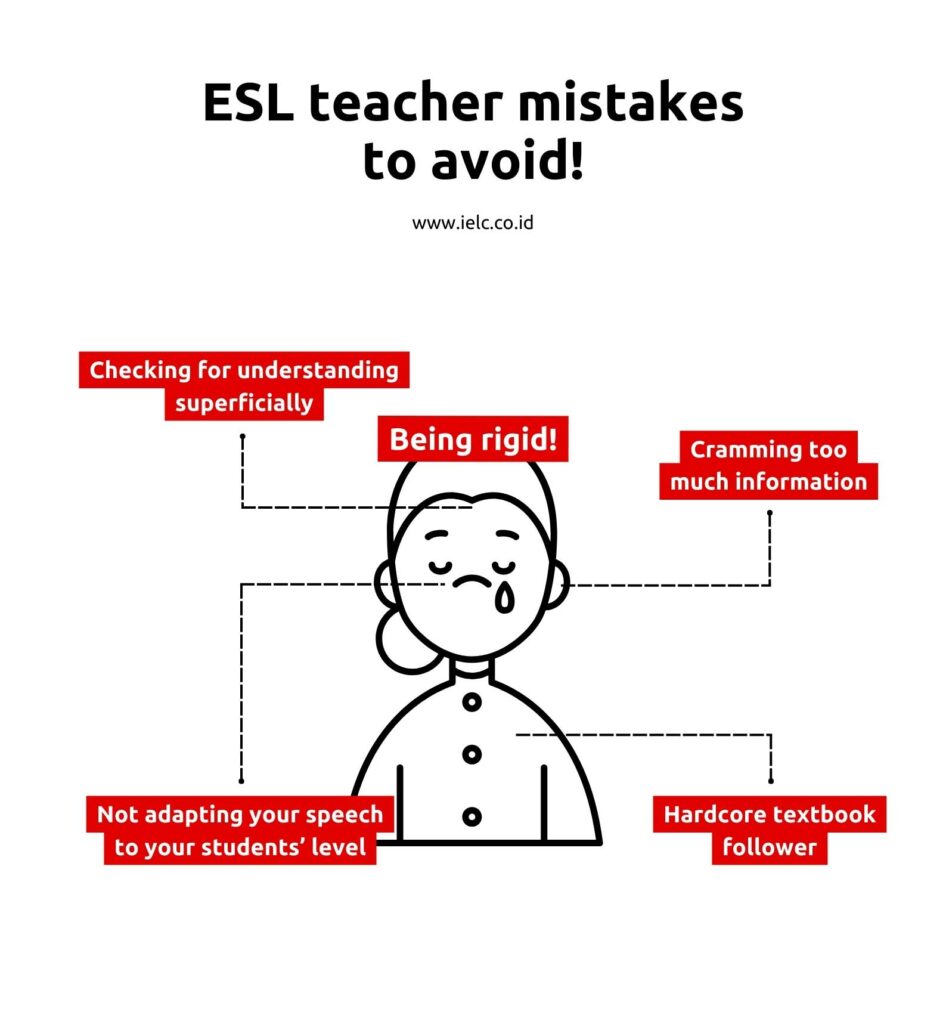
Attention ESL teachers! Are you making these mistakes?
How’s it going, ESL teachers?
Excited? Tired? A combination of the above?
We hope you are doing well! After all, you have a legion of students who look up to you for guidance in learning English! That’s no small task!
Today, we want to tell you about mistakes that ESL teachers often make.
Listen, mistakes do happen! We are all humans after all!
But identifying and understanding potential mishaps can help us be more mindful about our actions and therefore we’re less likely to make these mistakes.
So, without further do, let’s start!

1. Not adapting your speech to your students’ level
Let’s dive into a common slip-up we might be making without even realizing it – not tuning our language to the level of our students!
Imagine chatting away using big, complex words with a room full of beginners. Yep, that’s going to leave them scratching their heads more than learning!
The trick here is simple: simplify without dumbing down. We need to speak their language, literally! Keep it clear, keep it engaging, but don’t lose the essence of what you’re teaching. It’s not about watering down the content; it’s about making it accessible and digestible.
And hey, a picture or a simple illustration can often do wonders in bridging the language gap. Sometimes a quick doodle on the whiteboard can clear up confusion faster than a stream of words. Also, instead of putting our students on the spot with the dreaded “do you understand?” question, let’s try asking them to explain back or use the concept in their own words. It’s less intimidating and way more fun.
Let’s create a classroom environment where questions are the stars of the show, where curiosity drives the learning. When our students feel comfortable to ask, no matter how basic the question, that’s when we know real learning is happening!
2. You ask them if they understand
Going back to the previous point a little bit…
Of course we want to make sure that our students understand the lesson!
But think back to your schooling days, chances are you have encountered a teacher (or five!) who looked at you directly in the eyes and asked, “do you understand?”
Now, if you are anything like me, you probably felt pressured to say yes.
Now imagine how your students feel when you ask them that!
There are other ways to make sure your students understand the lesson without putting them on the spot and directly asking them if they understand.
Simply ask them questions related to the lesson to make sure they’ve understood. Or, as we discussed above, try asking them to explain back or use the concept in their own words. It’s less intimidating and way more fun!
3. Under challenging your students
If you don’t adequately challenge your students, they’ll lose their curiosity and motivation.
Of course, I am not saying that you should give your students really difficult exercises, that would kill their curiosity and motivation too!
Your task is to find just the balance of challenge so your students are always learning new things but not too hard that they get discouraged.
With that said, a lot of teachers fall into the trap of under challenging their students. This is especially prevalent in teachers of children. Don’t fall into the trap of modifying the games, exercises or tests to be easier just because they are children and you feel like they wouldn’t be able to understand.
You’d be surprised how much they are able to learn and accomplish! In fact, children are probably the quickest learners when it comes to languages!
4. All group work or all individual work
Students need both!
You can assign projects as group work. For example, you can ask them to make flyers or posters together. You can also assign group works to make some sort of plays or acting activity where each student in a group is assigned to different roles.
Group projects are very valuable to teach our students how to be collaborative. It teaches them to be assertive yet mindful of other people’s voices as well.
On the other hand, you can assign worksheets and writing practices as individual assignments to ensure your students understand all the learning materials.
Sure, some students work better alone and others thrive in group settings and like having friends to bounce ideas off. However, you should give your students a chance to experience both settings.
5. Hardcore textbook follower
What do we mean by this?
It means that you follow EVERYTHING in the textbook. The textbook is at the heart of the learning experience.
Not only is this boring, but you are also doing a disservice to your students.
Remember that first and foremost your goal should be to help your students learn and be confident in English.
So, if an activity derived from the textbook is not helpful to that goal, by any means, modify it, change it around!
Remember, your classroom should be student-centred not text-book centred!
6. Cramming too much information
Here’s the thing: when we bombard our students with a ton of information all at once, it’s like giving them a puzzle with too many pieces. They might get the big picture, but those crucial details? Lost in the mix!
The key? Break it down. Introduce concepts bit by bit, and then circle back, reinforcing them with fun activities and practical exercises. Think of it as building a language LEGO set. Each block is important, and together, they create something amazing.
And remember, repetition is our friend. It’s not just about introducing a concept; it’s about embedding it in their minds. With each repetition, each fun activity, each engaging conversation, those ideas and words get a little more ingrained.
Let’s aim to create lessons that are like a delightful meal, served in perfect portions, not an all-you-can-eat buffet that leaves everyone feeling overstuffed. It’s about finding that sweet spot where learning is exciting, comprehensive, and, most importantly, digestible!
7. Not engaging with all students
Alright, ESL teachers, let’s chat about another trap we might fall into – always counting on the same couple of students in class. We all have those eager beavers who are ready to jump in with answers, right? You know, the ones who always have their hands up first. But hey, there’s a whole classroom of potential out there!
There are students who might be quieter or less confident in their abilities. These students often go unnoticed and might feel left out. It’s important to encourage and engage these students too, ensuring they have equal opportunities to contribute and learn.
Our mission? To bring out the best in every student. Imagine your class as a tapestry, where each thread – every student – adds to the beautiful picture. Using a seating chart or random selection methods can be like a guide, helping us weave in all those unique threads evenly.
Encourage everyone to share their thoughts. Maybe that shy student in the back has a brilliant idea just waiting to be heard. And that student who always seems a bit lost? They might just need a little extra nudge to find their voice.
In the end, it’s about creating a classroom where everyone feels included and important. When every student gets a chance to contribute, that’s when the magic of collective learning really happens!
8. Being rigid
You know the drill – you’ve got your lesson plan polished, activities lined up, maybe even a backup plan just in case. But sometimes, that’s not quite enough!
Now, we’re not just talking about having your activities lined up (though that’s super important). However, the real art of teaching lies in your ability to stay fluid. It’s recognizing when a planned activity isn’t resonating and swiftly switching gears or when a spontaneous discussion offers a golden learning opportunity.
A well-prepared teacher is like a skilled sailor, ready to navigate any waters. But add flexibility to the mix, and you become a master navigator, able to adjust your sails to the shifting winds of classroom dynamics. Whether it’s altering an exercise to better suit the mood of the class, simplifying a complex topic, or keeping everyone on track amidst distractions, your ability to pivot is crucial!
So, let’s celebrate the power of preparation and the art of adaptability. Embrace the unexpected and be ready to evolve your teaching approach on the go!
Summary
So, do you find yourself doing one of these things?
If so, that’s okay! It’s not the end of the world.
We are constantly learning and improving, and part of our job is to be committed to professional development so we can always be the best version of ourselves.
One thing that you need to remember is that your goal should always be to help your students develop and grow. This must be your guiding anchor in determining all your classroom activities.
At IELC, we teach English the right way
Our goal is to get you speaking in English with fluency and confidence as fast as possible. We want to give you the skills you need to fulfil your potential!
Our experienced teachers will guide you along every step of the learning process to ensure that you are not wasting your time, money, and energy on useless language exercises & wrong methods.
Our courses
With our modern campus and technology, we are equipped to provide the best possible courses for children, teens, and adults, including:
Online and on campus IELTS courses
Online and on campus TOEFL PBT courses
Online and on campus TOEFL iBT courses
We offer our classes in group classes or private classes.
No matter what your goals are, our team will help you achieve these goals by providing you with Indonesia’s best English courses!
Talk to our team today to get your FREE consultation and take your first step towards success.
Sincerely,

IELC Academic Director
